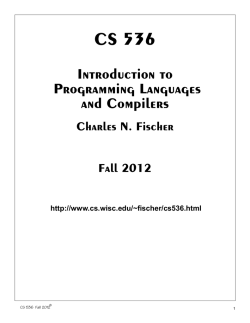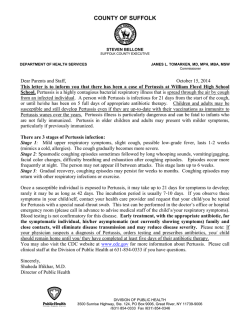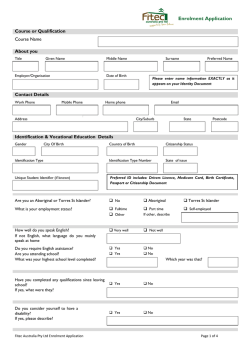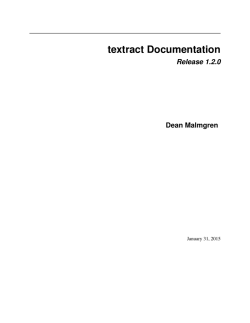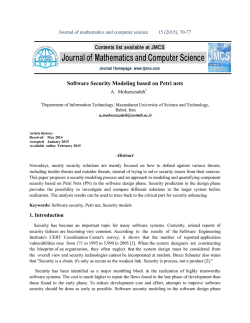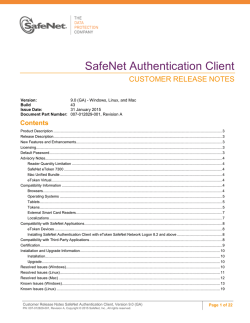
Top-down parsing
Parsing III
(Top-down parsing: recursive descent & LL(1) )
Copyright 2003, Keith D. Cooper, Ken Kennedy & Linda Torczon, all rights reserved.
Roadmap (Where are we?)
We set out to study parsing
• Specifying syntax
Context-free grammars
Ambiguity
• Top-down parsers
Algorithm & its problem with left recursion
Left-recursion removal
• Predictive top-down parsing
The LL(1) condition today
Simple recursive descent parsers today
Table-driven LL(1) parsers today
Picking the “Right” Production
If it picks the wrong production, a top-down parser may backtrack
Alternative is to look ahead in input & use context to pick correctly
How much lookahead is needed?
• In general, an arbitrarily large amount
• Use the Cocke-Younger, Kasami (CYK) algorithm or Earley’s algorithm
Fortunately,
• Large subclasses of CFGs can be parsed with limited lookahead
• Most programming language constructs fall in those subclasses
Among the interesting subclasses are LL(1) and LR(1) grammars
Predictive Parsing
Basic idea
Given A , the parser should be able to choose between &
FIRST sets
For some rhs G, define FIRST() as the set of tokens that appear
as the first symbol in some string that derives from
That is, x FIRST() if * x , for some
We will defer the problem of how to compute F IRST sets until
we look at the LR(1) table construction algorithm
Predictive Parsing
Basic idea
Given A , the parser should be able to choose between &
FIRST sets
For some rhs G, define FIRST() as the set of tokens that appear
as the first symbol in some string that derives from
That is, x FIRST() if * x , for some
The LL(1) Property
If A and A both appear in the grammar, we would like
FIRST() FIRST() =
This would allow the parser to make a correct choice with a lookahead
of exactly one symbol !
This is almost correct
See the next slide
Predictive Parsing
What about -productions?
They complicate the definition of LL(1)
If A and A and FIRST(), then we need to
ensure that FIRST() is disjoint from FOLLOW(), too
Define FIRST+() as
• FIRST() FOLLOW(), if FIRST()
• FIRST(), otherwise
Then, a grammar is LL(1) iff A and A implies
FIRST+() FIRST+() =
FOLLOW() is the set of
all words in the
grammar that can
legally appear
immediately after an
FIRST and FOLLOW Sets
FIRST()
For some T NT, define FIRST() as the set of
tokens that appear as the first symbol in some string
that derives from
That is, x FIRST() if
* x , for some
FOLLOW()
For some NT, define FOLLOW() as the set of
symbols that can occur immediately after in a valid
sentence.
FOLLOW(S) = {EOF}, where S is the start symbol
To build FOLLOW sets, we need FIRST sets …
Computing FOLLOW Sets
Computing FIRST Sets
for each α ∈ (T ∐ ε)
FIRST(α) ← α
for each A ∈ NT
FIRST(A) ← ∅
while (FIRST sets are still changing)
for each p ∈ P, where p has the form A → β
if β is β1β2...βk, where βi ∈ T ∐ NT, then
FIRST(A) ← FIRST(A) ∐ (FIRST(β1) – {ε})
i←1
while (ε ∈ FIRST(βi) and i < k)
FIRST(A) ← FIRST(A) ∐ (FIRST(βi+1) – {ε})
i ← i+1
if i = k and ε ∈ FIRST(βk), then
FIRST(A) ← FIRST(A) ∐ {ε}
Predictive Parsing
Given a grammar that has the LL(1) property
• Can write a simple routine to recognize each lhs
• Code is both simple & fast
Grammars with the LL(1)
Consider A 1 | 2 | 3, with
property are called
FIRST+(1) FIRST+ (2) FIRST+ (3) =
/* find an A */
if (current_word FIRST(1))
find a 1 and return true
else if (current_word FIRST(2))
find a 2 and return true
else if (current_word FIRST(3))
find a 3 and return true
else
report an error and return
false
predictive grammars
because the parser can
“predict” the correct
expansion at each point in
the parse.
Parsers that capitalize on
the LL(1) property are called
predictive parsers.
One kind of predictive
parser is the recursive
descent parser.
Of course, there is more detail to
“find a i”
(§ 3.3.4 in EAC)
Recursive Descent Parsing
Recall the expression grammar, after transformation
1
2
3
4
5
6
7
8
9
10
11
Goal
Expr
Expr'
→
→
→
|
|
Term
Term'
→
→
|
|
Factor
→
|
Expr
Term Expr'
+ Term Expr'
Term Expr'
ε
Factor Term'
* Factor Term'
/ Factor Term'
ε
number
id
This produces a parser with six
mutually recursive routines:
• Goal
• Expr
• Expr'
• Term
• Term'
• Factor
Each recognizes one NT or T
The term descent refers to the
direction in which the parse
tree is built.
Recursive Descent Parsing
(Procedural)
A couple of routines from the expression parser
Goal( )
token next_token( );
if (Expr( ) = true & token = EOF)
then next compilation step;
else
report syntax error;
return false;
Expr( )
if (Term( ) = false)
then return false;
else return Eprime( );
Factor( )
if (token = Number) then
token next_token( );
return true;
else if (token = Identifier) then
token next_token( );
return true;
else
looking for EOF,
report syntax error;
found token
return false;
EPrime, Term, & TPrime follow the
same basic lines (Figure 3.7, EAC)
looking for Number or
Identifier, found token instead
Recursive Descent Parsing
To build a parse tree:
• Augment parsing routines to
•
•
•
build nodes
Pass nodes between routines
using a stack
Node for each symbol on rhs
Action is to pop rhs nodes, make
them children of lhs node, and
push this subtree
To build an abstract syntax tree
• Build fewer nodes
• Put them together in a different
order
Expr( )
result true;
if (Term( ) = false)
then return false;
else if (EPrime( ) = false)
then result false;
else
build an Expr node
pop EPrime node
pop Term node
make EPrime & Term
children of Expr
push Expr node
return result;
Success build a piece of the parse tree
Left Factoring
What if my grammar does not have the LL(1) property?
Sometimes, we can transform the grammar
The Algorithm
A NT,
find the longest prefix that occurs in two
or more right-hand sides of A
if ≠ then replace all of the A productions,
A 1 | 2 | … | n | ,
with
AZ |
Z 1 | 2 | … | n
where Z is a new element of NT
Repeat until no common prefixes remain
Left Factoring
A graphical explanation for the same idea
1
A 1
| 2
| 3
A
3
becomes …
AZ
Z 1
| 2
| n
2
1
A
Z
2
3
Left Factoring
(An example)
Consider the following fragment of the expression grammar
1 Factor
2
3
→ Identifier
| Identifier [ ExprList ]
| Identifier ( ExprList )
After left factoring, it becomes
1 Factor
2 Arguments
3
4
→
→
|
|
Identifier Arguments
[ ExprList ]
( ExprList )
ε
FIRST(rhs1) = { Identifier }
FIRST(rhs2) = { Identifier }
FIRST(rhs3) = { Identifier }
FIRST(rhs1) = { Identifier }
FIRST(rhs2) = { [ }
FIRST(rhs3) = { ( }
FIRST(rhs4) = FOLLOW(Factor)
It has the LL(1) property
This form has the same syntax, with the LL(1) property
Left Factoring
Graphically
Identifier
Factor
Identifier
[
ExprList
]
No basis for choice
Identifier
(
ExprList
)
[
ExprList
]
(
ExprList
)
becomes …
Factor
Identifier
Word determines
correct choice
Left Factoring
(Generality)
Question
By eliminating left recursion and left factoring, can we
transform an arbitrary CFG to a form where it meets the LL(1)
condition? (and can be parsed predictively with a single token
lookahead?)
Answer
Given a CFG that doesn’t meet the LL(1) condition, it is
undecidable whether or not an equivalent LL(1) grammar
exists.
Example
{an 0 bn | n 1} {an 1 b2n | n 1} has no LL(1) grammar
Language that Cannot Be LL(1)
Example
{an 0 bn | n 1} {an 1 b2n | n 1} has no LL(1) grammar
G aAb
| aBbb
A aAb
| 0
B aBbb
|1
Problem: need an unbounded number
of a characters before you can
determine whether you are in the
A group or the B group.
Recursive Descent (Summary)
1. Build FIRST (and FOLLOW) sets
2. Massage grammar to have LL(1) condition
Remove left recursion
b. Left factor it
a.
3. Define a procedure for each non-terminal
Implement a case for each right-hand side
b. Call procedures as needed for non-terminals
a.
4. Add extra code, as needed
Perform context-sensitive checking
b. Build an IR to record the code
a.
Can we automate this process?
Building Top-down Parsers
Given an LL(1) grammar, and its FIRST & FOLLOW sets …
• Emit a routine for each non-terminal
Nest of if-then-else statements to check alternate rhs’s
Each returns true on success and throws an error on false
Simple, working (, perhaps ugly,) code
• This automatically constructs a recursive-descent parser
Improving matters
• Nest of if-then-else statements may be slow
Good case statement implementation would be better
• What about a table to encode the options?
Interpret the table with a skeleton, as we did in scanning
Building Top-down Parsers
Strategy
• Encode knowledge in a table
• Use a standard “skeleton” parser to interpret the table
Example
• The non-terminal Factor has three expansions
( Expr ) or Identifier or Number
• Table might look like:
Terminal Symbols
Non-terminal
Symbols
Factor
+
-
*
/
Id.
—
—
—
—
10
Error on `+ ’
Num. EOF
11
—
Reduce by rule 10 on `+ ’
Building Top Down Parsers
Building the complete table
• Need a row for every NT & a column for every T
• Need a table-driven interpreter for the table
LL(1) Skeleton Parser
token next_token()
push EOF onto Stack
push the start symbol, S, onto Stack
TOS top of Stack
loop forever
if TOS = EOF and token = EOF then
break & report success
exit on success
else if TOS is a terminal then
if TOS matches token then
pop Stack
// recognized TOS
token next_token()
else report error looking for TOS
else
// TOS is a non-terminal
if TABLE[TOS,token] is A B1B2…Bk then
pop Stack
// get rid of A
push Bk, Bk-1, …, B1 // in that order
else report error expanding TOS
TOS top of Stack
Building Top Down Parsers
Building the complete table
• Need a row for every NT & a column for every T
• Need an algorithm to build the table
Filling in TABLE[X,y], X NT, y T
1. entry is the rule X , if y FIRST( )
2. entry is the rule X
if y FOLLOW(X ) and X G
3. entry is error if neither 1 nor 2 define it
If any entry is defined multiple times, G is not LL(1)
This is the LL(1) table construction algorithm
Extra Slides Start Here
Recursive Descent in Object-Oriented Languages
• Shortcomings of Recursive Descent
Too procedural
No convenient way to build parse tree
• Solution
Associate a class with each non-terminal symbol
Allocated object contains pointer to the parse tree
Class NonTerminal {
public:
NonTerminal(Scanner & scnr) { s = &scnr; tree = NULL; }
virtual ~NonTerminal() { }
virtual bool isPresent() = 0;
TreeNode * abSynTree() { return tree; }
protected:
Scanner * s;
TreeNode * tree;
}
Non-terminal Classes
Class Expr : public NonTerminal {
public:
Expr(Scanner & scnr) : NonTerminal(scnr) { }
virtual bool isPresent();
}
Class EPrime : public NonTerminal {
public:
EPrime(Scanner & scnr, TreeNode * p) :
NonTerminal(scnr) { exprSofar = p; }
virtual bool isPresent();
protected:
TreeNode * exprSofar;
}
… // definitions for Term and TPrime
Class Factor : public NonTerminal {
public:
Factor(Scanner & scnr) : NonTerminal(scnr) { };
virtual bool isPresent();
}
Implementation of isPresent
bool Expr::isPresent() {
Term * operand1 = new Term(*s);
if (!operand1->isPresent()) return FALSE;
Eprime * operand2 = new EPrime(*s, NULL);
if (!operand2->isPresent()) // do nothing;
return TRUE;
}
Implementation of isPresent
bool EPrime::isPresent() {
token_type op = s->nextToken();
if (op == PLUS || op == MINUS) {
s->advance();
Term * operand2 = new Term(*s);
if (!operand2->isPresent()) throw SyntaxError(*s);
Eprime * operand3 = new EPrime(*s, NULL);
if (operand3->isPresent()); //do nothing
return TRUE;
}
else return FALSE;
}
Abstract Syntax Tree Construction
bool Expr::isPresent() { // with semantic processing
Term * operand1 = new Term(*s);
if (!operand1->isPresent()) return FALSE;
tree = operand1->abSynTree();
EPrime * operand2 = new EPrime(*s, tree);
if (operand2->isPresent())
tree = operand2->absSynTree();
// here tree is either the tree for the Term
//
or the tree for Term followed by EPrime
return TRUE;
}
Abstract Syntax Tree Construction
bool EPrime::isPresent() { // with semantic processing
token_type op = s->nextToken();
if (op == PLUS || op == MINUS) {
s->advance();
Term * operand2 = new Term(*s);
if (!operand2->isPresent()) throw SyntaxError(*s);
TreeNode * t2 = operand2->absSynTree();
tree = new TreeNode(op, exprSofar, t2);
Eprime * operand3 = new Eprime(*s, tree);
if (operand3->isPresent())
tree = operand3->absSynTree();
return TRUE;
}
else return FALSE;
}
Factor
bool Factor::isPresent() { // with semantic processing
token_type op = s->nextToken();
if (op == IDENTIFIER | op == NUMBER) {
tree = new TreeNode(op, s->tokenValue());
s->advance();
return TRUE;
}
else if (op == LPAREN) {
s->advance();
Expr * operand = new Expr(*s);
if (!operand->isPresent()) throw SyntaxError(*s);
if (s->nextToken() != RPAREN) throw SyntaxError(*s);
s->advance();
tree = operand->absSynTree();
return TRUE;
}
else return FALSE;
}
© Copyright 2025


